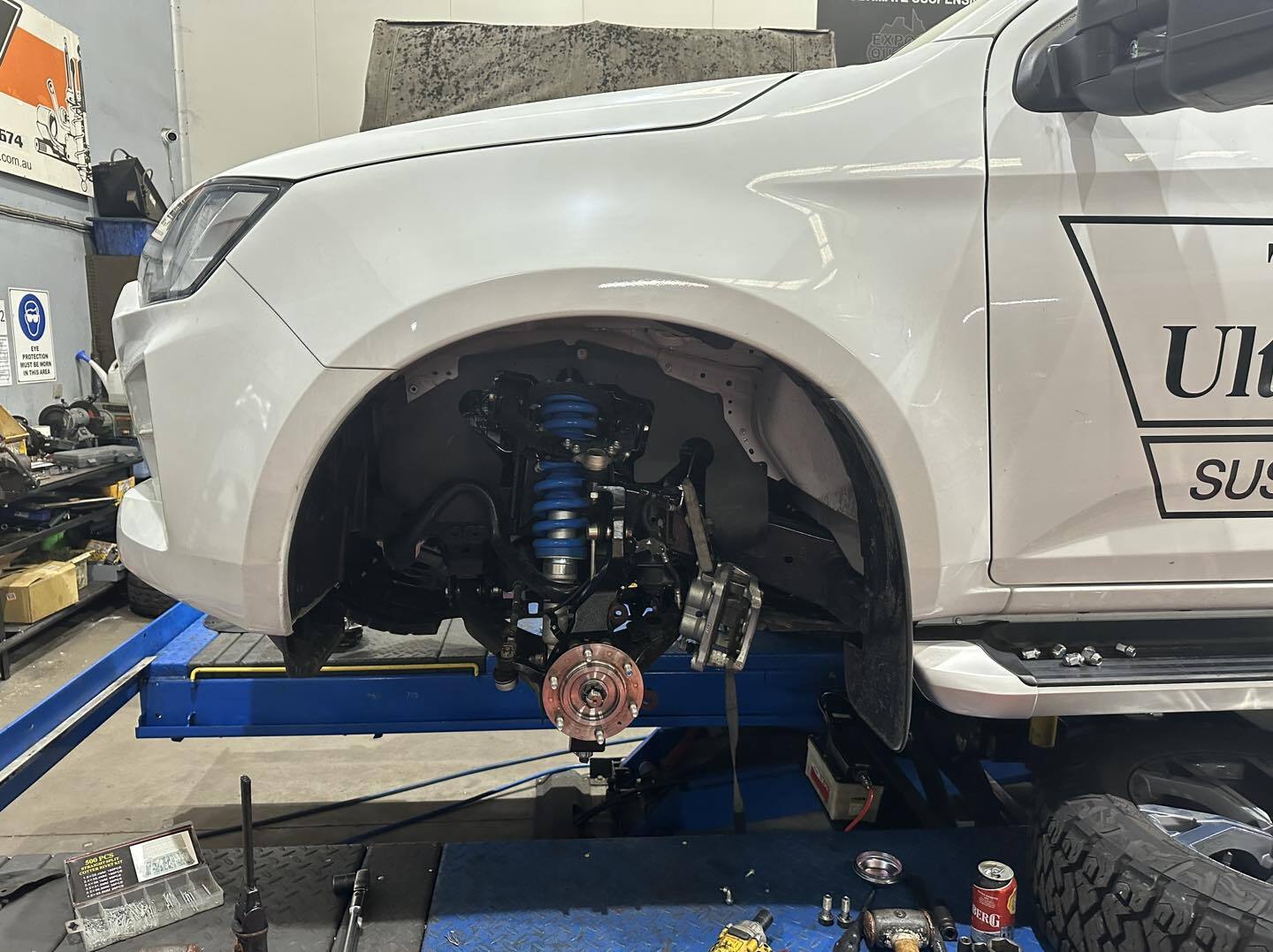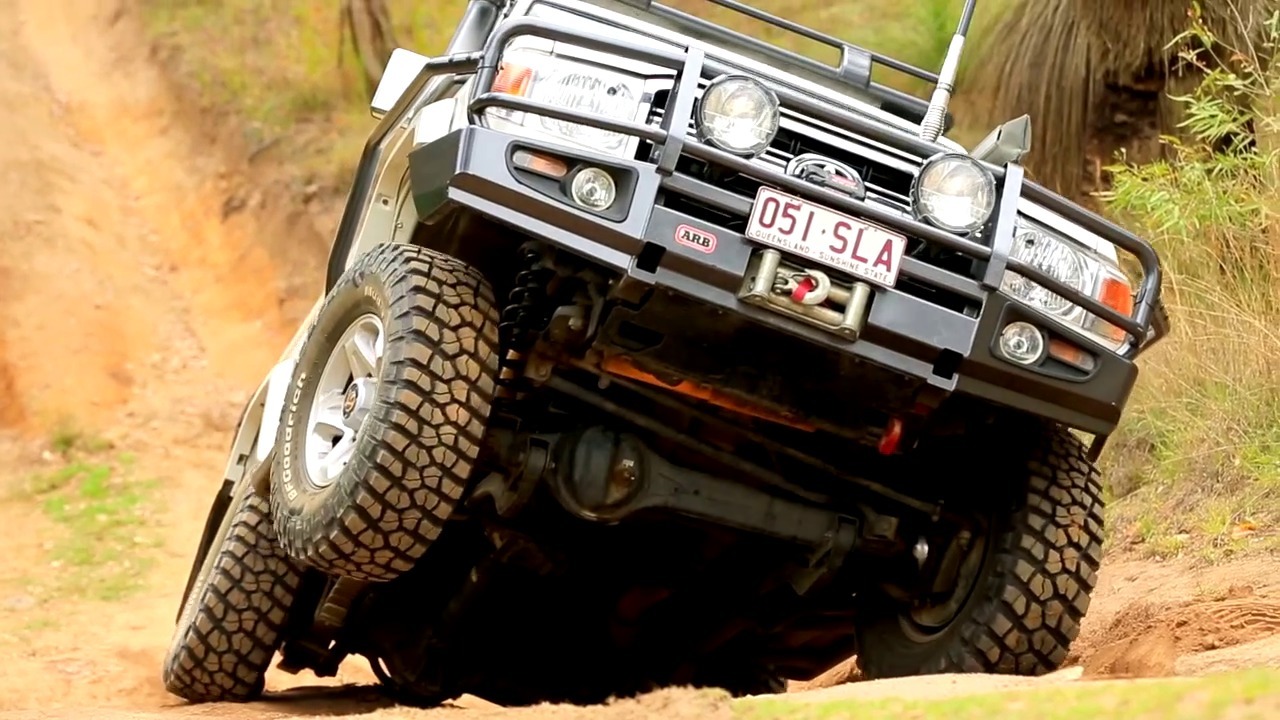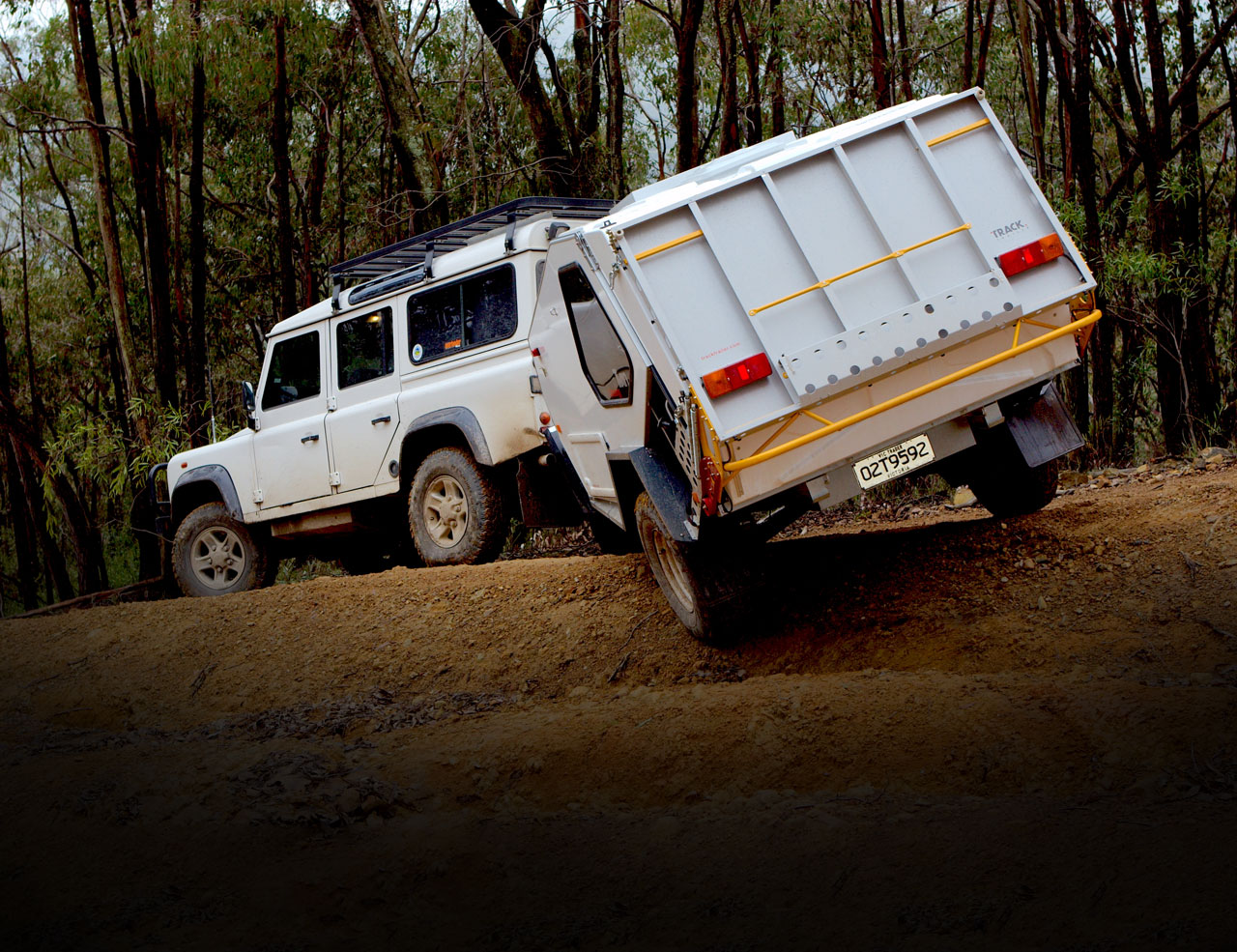When it comes to 4X4s and off-road driving in general, few things will affect a vehicle’s performance in the rough stuff more than the suspension you’re running. Getting it right can be an exercise in frustration for the uninitiated. So we thought we’d throw together a bit of a reference guide to familiarise you with the big bad world of springs, shock absorbers and on and off-road handling.

There are several things to keep in mind before you embark on the “new suspension” road. Rule one is that ALL suspension is a compromise. If there was a perfect system available then not only would all manufacturers run it, but all of the comp guys too. Suspension is there to be great at a few things, which you need to identify. Do you tow? Do you carry regular weight? Have you modified the vehicle?
Rule two: Australian legalities make building a truly functional suspension for a road-going 4X4 essentially impossible. As much as we’d all love obscene amounts of travel, fancy link set-ups and tyres kicked out well clear of the guards, it ain’t going to happen until we have an American-style civil war. And not many of us are willing to take up arms in pursuit of truth, justice and double-triangulated 4-links. So, manage your expectations accordingly there…

Now, rule three is a lot more upbeat. Namely, we are incredibly lucky here in Australia to have a slew of aftermarket suspension companies that not only live and breathe this stuff (so you don’t have to), but they can make your bouncy bits work orders of magnitude better than they ever did from the factory.
Let’s jump into what 4×4 suspension is, how it works, how it doesn’t and what you need to do to make it better off-road

Solid axle
This refers to a type of differential that has a rigid steel housing between the front or (usually) rear wheels. The suspension system is what connects this solid axle to the chassis. Broadly speaking, they come in two flavours: leaf springs and coils (we’ll get to both in a sec). While solid axles are generally stronger and have more load carrying ability than the alternatives, the main reason four-wheel drivers like `em is that they are easier to lift and capable of a lot more suspension travel (flex) than anything else.
That comes at a price, however, with the ride being rougher (particularly over corrugated roads) and the ground clearance under the diff usually being reduced. Also, manufacturers are increasingly stepping away from the solid axle set-up, with only a couple of vehicles (LC70s, Jeep Wrangler and Suzuki Jimny) holding onto what’s frankly, old tech.
Pros:
Easy to lift
Simpler Design
Load carrying
Cons:
High speed handling not as good
Swivel hub rebuilds (IYKYK)
Rougher riding

Independent front suspension
Independent Front Suspension is what every other kid in the sandbox plays with. This is where the differential is hard mounted to the chassis, and the wheels move up and down via a series of control arms running laterally across the frame.
There are a bunch of different configurations but the most common is the coilover strut (a coil spring with a shock absorber running up through the centre) and double A-arm combination. This is found in every mid-size dual-cab, all the wagons built from ute platforms, Prados, Pajeros… you name it and it probably has this permutation of IFS.
This is mainly due to the fact that thirty years ago, if you wanted a big and tough ute for off-road driving, you were willing to put up with the rougher ride and agricultural feel of a solid axle. Nowadays people use utes more for a multitude of roles, not just off-road pursuits, so manufacturers have catered for them with increased interior comfort and these much nicer riding front suspension systems.

And if you’re chasing a couple inches of lift, then the aftermarket has you well and truly covered. If you’re chasing serious rock-crawling performance though, you’re going to run into limitations fairly quickly. That’s not to say that anything is impossible, with the right key upgrades.
Some old-school off-road people like to rubbish IFS. But despite its propensity for running out of travel and lifting wheels, with diff lockers or a decent traction control system most of the limitations can be overcome without too many dramas. Unless you’re hell-bent on a solid axle, IFS is almost always the better option.
Pros:
Better handling
Smoother ride
Plenty of aftermarket support
Cons:
Difficult to get big lifts
More expensive to modify
More complex

Leaf Springs
Leaf springs have been around since the horse and cart days and are still used on heavy load carrying vehicles like utes (usually out the back end) and work trucks. A leaf spring is made up of several long strips of semi-elliptical spring steel, layered together and attached to the chassis at one end by a shackle that moves through an arc as the spring flexes and a solid mount at the other end. It’s bolted to a solid axle housing in the middle.
Leaves are inherently progressively rated, meaning they get stiffer the more load is placed on them, which is excellent for heavy loads, however they do suffer in the flex and ride quality departments. They’re also the heaviest type of spring there is, so replacing them with aftermarket items can be cumbersome, but worth the cost as you can dial in the carrying capacity to suit your needs perfectly.
Pros:
Simple
Fantastic for heavy duty use
Can be tweaked to suit your needs
Cons:
Rough ride
Not much suspension travel (under usual applications)
Need to be a member of a crossfit gym to replace them

Parabolic leaf springs
While the design of parabolic leaf springs is similar to regular leaves, there’s enough difference to warrant mentioning them separately. Parabolic items have each spring within the spring pack tapered at the ends and thicker in the middle. Without going into unnecessary detail, the result is a spring pack that’s quieter, rides better and flexes more easily off-road. Terrain Tamer offer a range of parabolic springs and are well worth checking out.

We even installed them into our recent Project D-Max build, which you can check out here.
Pros:
Quieter operation
Better flex
No lost load carrying capacity
Cons:
Only available on the aftermarket
If one spring breaks, the whole pack is shagged
Work optimally when loaded

Coil springs
Coils are easily the most common spring found on 4X4s today. A spiral of steel is wound in a certain way to provide the desired spring rate and lift characteristics. As the suspension compresses, the spiral twists into a shorter height, and as the suspension droops the spiral opens out into a taller length. The more spirals in the length of the coil, the lower the spring rate (the softer it is) and the fewer the higher the spring rate (the stiffer it is).
Coils offer a great balance between ride quality, load carrying and handling, however, they’re more complicated to design and set-up than an equivalent leaf spring system. The require trailing arms and control arms (suspension links than run longitudinally and laterally relative to the frame respectively) in order to keep the wheel travel characteristics under control. This link design is what determines overall flex and handling.
They can be replaced with aftermarket items for more lift and more (or less) load carrying and are available in progressive rates as well.
Pros:
Easy to lift
Cheap to replace
Great ride and flex
Cons:
Can be overwhelmed when carting or towing heavy
Require more complex suspension systems than leaves
For a complete suspension upgrade things can get expensive

Shock absorbers
In basic engineering terms, shock absorbers take the kinetic energy from your springs’ up and down movement and turn it into thermal energy, which is dissipated through the shock body. Of course, that’s a huge oversimplification and the science behind shock absorbers is incredibly in-depth. The gist of shocks though is to get ones that are the correct length for your available travel, have the correct valving for the driving you do and make sure they’re robust enough that they don’t overheat on the PDR up at Cape York and you’re left wondering why your ride quality just suddenly became hot garbage.

They work by having a central shaft that moves a piston up and down the shock body, through hydraulic fluid (some use gas to minimise aeration of the fluid). The piston has valve plates that allow the fluid to pass through, dictating the travel rate of the shock. Some shocks have manually adjustable valving (usually through a knob on the shock body) that allows you to tweak things to your taste.
The easiest way to determine which brand is for you is to have a chat with your friendly suspension expert (companies like The Ultimate Suspension, Superior Engineering, Terrain Tamer or Outback Armour from our experience would be great places to start) and work out what you’ll be doing with your rig, how much lift you’re running and what your budget is.
Pros:
Good shocks can transform a vehicle’s ride and handling
Aftermarket units are almost always much better than the factory units
You can customise your handling characteristics with adjustable units
Cons:
Top quality units ain’t cheap
Choosing the right shocks can be a process
The science behind shocks is a black art and easy to get wrong

Bushes
Correct me in the comments if I’m wrong here, but off the top of my dome I’m pretty sure every single component in your suspension uses some sort of bush for vibration dampening (I guess you could argue tyres are a part of the suspension and don’t use a bush, but also, pipe down pedant). Bushes are made from rubber or poly-plastic and are designed to isolate componentry from shaking itself to pieces over rough terrain.
A bush’s effectiveness basically comes down to its duro rating (or hardness). The softer it is the more vibrations it absorbs but will wear out more quickly. The harder, the more vibes it’ll transfer through the suspension, but will likely outlast Taylor Swift’s impact on society. Most factory bushes are made of rubber while many aftermarket items are poly, and while one is not necessarily better than the other, choosing the right duro is paramount. Again, chat to your suspension expert to see what will work for your needs.
Pros:
The right bushes will make for a much nicer suspension set-up
Replacing bushes is generally affordable and not difficult
Better performance both on and off-road
Cons:
Too hard bushes will increase vibrations and inhibit flex
Finding out what duro works for which individual bush can be troublesome
Specialist knowledge required to get the most out of your bushes

Radius arms
Radius arms are a common means of locating a solid axle under the frame. They mount to the diff at two points on the housing (usually above and below or fore and aft) then run back to the frame. The diff is located laterally by a Panhard rod, which runs from the housing up to the driver’s side of the frame. This is because the Panhard must be parallel to the steering arm, if it’s not you’ll get bump-steer – or that feeling when you hit a slight bump with your front wheels and the steering wheel is dangerously reefed from your hands. Not cool.
Radius arms are favoured by many manufacturers as they are easy to design and offer decent amounts of flex when the suspension is standard. They do lose out on travel when lifts are fitted to the vehicle, but it’s nothing the aftermarket can’t solve. Superior Engineering Superflex Arms are a good example of designing around the limitations of radius arms.
Pros:
Easy to set-up
Offer a great compromise between flex and handling
Work incredibly well at stock height
Cons:
Not conducive to big lifts (without replacement)
Are designed to bind as standard
Is largely dependent on bush design for wheel travel

Link systems
Links are just another name for trailing and control arms. It’s actually a pretty confusing subject as there are a bunch of different types and they have fairly similar names depending on the number of links used in the system. Kicking things off is the 3-link set-up (3-link + Panhard, Radius Arms and A-frame are all nominally 3-links), then the 4-link (Parallel 4-link, single triangulated 4-link, double triangulated 4-link) and then the 5-link (which is also referred to as a parallel 4-link + Panhard).
Clear as mud? Yeah, it’s a mess and pretty confusing.
Essentially, a link system is used on a solid axle with coils or coilovers and can be designed for maximum flex, to replace an existing inferior link set-up, to swap from leaves to coils or just about anything in between.
Pros:
Offers lots of wheel travel
Should put power to the ground more effectively
Can be dialled to suit whatever you need
Cons:
Complicated to design
Requires specialist fitment
Can easily bind up if incorrect for application

4×4 Suspension lift kits
As the name implies, a lift kit is there to raise your vehicle via taller springs and shocks in the suspension, giving you ground clearance and the ability to fit bigger tyres. A comprehensive lift kit will include springs and shocks plus all of the ancillary components to make it all work. Things like extended brake lines, steering extensions, suspension geometry corrective measures and the all important sticker that’ll easily add 10kW at the wheels. Because science.
As you might expect, there are lift kits and there are lift kits. Some suck and some are amazing. A good rule to follow is to stick to the major players (such as the companies we list in this article that we trust and recommend) and be wary of the eBay specials.
It’s worth noting that there’s an art to fitting up suspension too, particularly on some IFS vehicles, so if you’re not confident getting it done yourself don’t be shy to take it to your local 4X4 specialist. The amount of flogged out bushes, leaky shocks and munted bolts we’ve seen thanks to improper installation is the stuff of nightmares.
Pros:
A good kit is off the shelf and awesome for your vehicle
Not too expensive or time-consuming to fit in most cases
Will accommodate for the extra weight of all your accessories and trailer
Cons:
A poor kit can be downright dangerous
Getting the install wrong will cost you
One size fits all, but may not be 100% dialled for your needs

Custom to suit your needs
If a lift kit is not quite ticking the boxes, you’ll need to go a little deeper and start looking at custom set-ups. These are only limited by your imagination and wallet, but getting things like the shocks tuned precisely, the spring rates bang on and the ride heights perfect for your usage can be the difference between a hassle-free trip away and the road trip from the 9th level of Hades.
This really is a “how long is a piece of string” scenario, but custom kits often start with replacement arms, one-off springs, highly tuned shocks and go from there.

The Ultimate Suspension in Sydney, my local suspension experts, told me on my last visit to see them that they could build me a set of springs and shock absorbers for my FJ Cruiser to custom specifications. This would suit the weight I carry. As well as offer more suspension travel with the potential of running longer shock absorbers. This service extends to all popular makes and models, including (but not limited to) Toyota HiLux, Isuzu D-Max, Mitsubishi Triton, Ford Ranger and the 70 Series LandCruiser platform.
I thought was a really neat approach to four-wheel drive suspension upgrades. This bespoke style of suspension will get you exactly what you need, be that for carrying more weight or for better performance on and off-road.
Pros:
Everything dialled to suit your driving and your rig
Perfect if you have unique requirements an off the shelf product can’t solve
The smile whenever you hit the rough stuff and know your fourby will handle it
Cons:
Extra cost
Getting things tuned to perfection takes time and effort
Not always a stocked item, custom means custom










